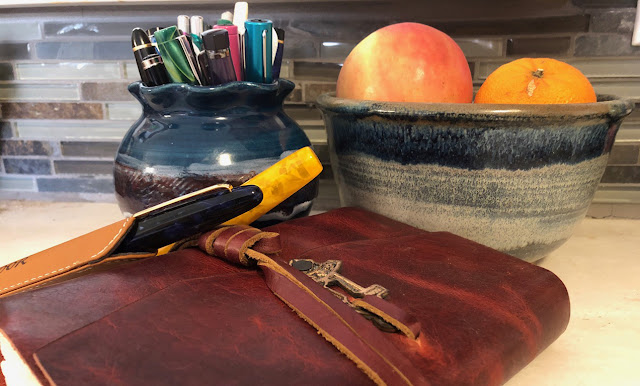By G. S. Norwood
It’s the time of year when many of us look back to review the year we’ve just lived through and look ahead to what we want for ourselves in the year to come. And yes, I’m doing that, with all my journals and planners and pens loaded with different colored inks. But lately I’ve had more than a few lifetime-level “Pinch Me” moments, so today I’m going to look back at my career, and ask myself, “How did I get here?”
 |
| G.’s trusty pens and journal: photo originally published in a 2020 post on The Weird Blog. (see credits below). |
The Kid From Missouri
Let’s face it. I am just a kid from Missouri. I grew up in small towns, the daughter of two public school teachers. We weren’t rich. We weren’t well-connected. And, although liberal, we were hardly members of the “Liberal Elite.” I went to a state university, not Harvard.
Nor was I born into a famous family, or a social circle with members of international renown.
My parents, and eventually my sister, were all teachers. I figured I would be, too. What else did I know? In fact, when I decided NOT to pursue a teaching degree, my mother openly worried that I would never be able to support myself. Clearly her career expectations for me were modest.
A Life in the Arts
And yet . . . A friend once said of me, “Gigi has met more famous people than anybody else I know.” I’ll be honest. I’ve met a lot of famous people, from Poul Anderson to Sonny Landreth. In the process, I’ve realized that fame is frequently restricted to the professional circles you move in. Plenty of people reading this blog post will have no idea who either Poul Anderson or Sonny Landreth might be. Others will say, “Wait. You’ve worked with who now????”
The thing is, I wanted a life in the arts. I didn’t have to be some fabulous Broadway star, but I learned early on that I loved the work of putting on a show. You can find real magic in creating experiences to share with audiences. I was adapting fairy tales and directing plays in my back yard by the time I was in the fourth grade. I learned to make costumes in a professional summer stock theatre company as a junior in high school. Scholarships and my work as a paid staff member of Missouri State’s Tent Theatre got me through college.
 |
| Science fiction grandmaster Poul Anderson (L) and world-class guitarist Sonny Landreth (see credits below). |
Iconic Conductors
That kid in Missouri listened to a lot of classical music, but I never dreamed I’d meet internationally acclaimed conductors. Conductors were distant icons, like Leonard Bernstein. And yet, I once found myself sitting at my dining table in a rural part of west Texas, interviewing a highly respected German conductor via an international phone call. No big deal for a woman who wrote the newsletter for the Dallas Symphony Orchestra, where the conductor was scheduled to appear. But that little girl from Missouri, who still lives in the back of my brain? She was saying, “Wait. How did I get here?”
Missouri Girl piped up again that time my friend, the internationally acclaimed novelist, wondered how she might interview someone at the New York City Ballet about The Nutcracker. The New York City Ballet is an icon of the American arts world, as far above local ballet companies as the gods on Olympus. Then I realized, “Oh! I know Andrew Litton, their conductor.” How did that happen?
 |
| L-R: The Dallas Symphony on stage for Christmas 2021, Conductor Andrew Litton, and two dancers from the New York City Ballet (see credits below). |
Composers in My Car
And then there are the composers. I grew up thinking composers were dead guys like Mozart, Beethoven, and Tchaikovsky. These days I get to fist-bump a whole pantheon of contemporary composers, some of whom are writing commissions for my own Dallas Winds.
Which is how I have found myself chatting about cars with Omar Thomas, recommending Italian restaurants to Frank Ticheli, and winding up with a Bacon number of 2, thanks to Steven Bryant. I’ll always cherish the 45-minute one-on-one conversation I had when I drove the revered wind ensemble composer David Maslanka to a speaking engagement in Fort Worth. Ditto the lunch I shared with composer/conductor/choral music superstar Eric Whitacre.
 |
| Clockwise from left: Omar Thomas; David Maslanka, Steven Bryant, Eric Whitacre, and Frank Ticheli (see credits below). |
Just Say Yes
I don’t say all this to brag about my friends or my accomplishments. I’m just a woman who works hard to support myself, in a field I find fascinating. And how did I get here? I knew I was most comfortable working in the arts, so I said “Yes!” to the opportunities I encountered. But it would never have happened if I hadn’t believed it was possible.
When I went looking for jobs, I didn’t look at the listings for bank teller or retail clerk. I looked in the arts. And I wasn’t super picky. Over the years I’ve worked as house manager for small-scale folk music house concerts. I’ve written newsletters and grant proposals for the Dallas Symphony Orchestra and shepherded a bus full of Dallas Winds musicians through rural Oklahoma to a concert gig in Arkansas. Rarely was it glamorous, but it was always fun.
 |
| This Mustang, “Roze,” has carried many famous composers to places they needed to go. (Photo by G. S. Norwood). |
Make Your Own Opportunities
In 2011 the Dallas Winds recorded a collection of Christmas music. The record company didn’t know what they wanted to do about liner notes. I told them I had an idea, and they invited me to have a go. They liked what I wrote, so if you ever happen to check out the Dallas Winds CD Horns for the Holidays, you’ll see the result.
On the way home from our most recent Christmas concert, I tuned in to WRR-FM, Dallas’ fabled classical music station. The announcer was introducing the next work with words that sounded strangely familiar. “That has to be Alfred Reed’s Russian Christmas Music,” I thought. Sure enough, and it was the Dallas Winds’ recording of it. Every classical music lover in a four-state region had just heard those liner notes I wrote on an off chance back in 2011.
That would not have happened if I had opted for a career in education.
 |
| The Dallas Winds holiday album mentioned in the post, and the wind ensemble in a recent photo with conductor Jerry Junkin (see credits below). |
So . . . How Did I Get Here?
It wasn’t talent, or connections, or blinding ambition that got me where I am right now. I simply held out for the adventure. I wanted a career in the arts, and looked for any opportunity. When you do that, opportunities open up. Composers and conductors hop in for a ride in my little red Mustang. The liner notes from that Christmas CD led to liner notes for a John Williams recording. That recording wound up being nominated for a Grammy Award. A slightly surreal moment for that kid from Missouri.
Which is all just to say that, if you dream of a career in the arts, go for it. Your mother may fear for your solvency, and your more conventional relatives may sniff at the way your jobs reconfigure themselves every few years. But you can make your living in the arts. You may not get rich and famous, but you’ll have a whole lot of fun. And, someday, you may look back on the whole crazy trail you’ve left and wonder, “How did I get here?”
IMAGE CREDITS
G. and Jan have ourselves to thank for a couple of the photos used in this post. One is the “Journal and Pens” photo by G. S. Norwood, first used for the post “Necessary Indulgences” a little more than a year ago. The hand-crafted journal is by Iona Handcrafted Books, and the pen holder is by Janet Rodriguez of Hart Street Pottery. The other is the photo of Omar Thomas, originally from his website, first used almost a year ago in the post, “Why We Need to Represent.” G. also provided the photo of her red Mustang GT.
The photo of master science fiction author Poul Anderson is from his Amazon Author Page, with a glimpse of a few of his books courtesy of Goodreads. Many thanks to The Ark in Ann Arbor, MI, for the photo of world-renowned guitarist Sonny Landreth, doing what he does best. We also appreciate the public Facebook pages of The Dallas Symphony Orchestra, The New York City Ballet, and conductor Andrew Litton for their representative photos.
There are lots of people to thank for the montage of marvelous composers. We’ve already mentioned the wonderful portrait of Omar Thomas, above. Our thanks also go out to Steven Bryant and Frank Ticheli (Photo by Frank Ticheli - Sent by subject; also published on the J W Pepper Blog, CC BY-SA 4.0 via Wikimedia Commons) for their photos. David Maslanka’s son Matthew Maslanka provided the photo of his father composing (presumably his 10th Symphony). And the wonderful photo of Eric Whitacre in his “Choir Geeks” T-shirt is by Marc Royce, via WOSU. Finally, we thank Reference Recordings for the Horns for the Holidays album cover, and the Dallas Winds for the photo of that ensemble taking a well-deserved bow (led by Conductor Jerry Junkin). All montages are by Jan S. Gephardt. Deepest gratitude to all!


















